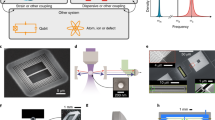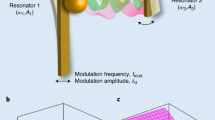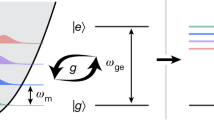Abstract
Hybrid quantum optomechanical systems1 interface a macroscopic mechanical degree of freedom with a single two-level system such as a single spin2,3,4, a superconducting qubit5,6,7 or a single optical emitter8,9,10,11,12. Recently, hybrid systems operating in the microwave domain have witnessed impressive progress13,14. Concurrently, only a few experimental approaches have successfully addressed hybrid systems in the optical domain, demonstrating that macroscopic motion can modulate the two-level system transition energy9,10,15. However, the reciprocal effect, corresponding to the backaction of a single quantum system on a macroscopic mechanical resonator, has remained elusive. In contrast to an optical cavity, a two-level system operates with no more than a single energy quantum. Hence, it requires a much stronger hybrid coupling rate compared to cavity optomechanical systems1,16. Here, we build on the large strain coupling between an oscillating microwire and a single embedded quantum dot9. We resonantly drive the quantum dot’s exciton using a laser modulated at the mechanical frequency. State-dependent strain then results in a time-dependent mechanical force that actuates microwire motion. This force is almost three orders of magnitude larger than the radiation pressure produced by the photon flux interacting with the quantum dot. In principle, the state-dependent force could constitute a strategy to coherently encode the quantum dot quantum state onto a mechanical degree of freedom1.
This is a preview of subscription content, access via your institution
Access options
Access Nature and 54 other Nature Portfolio journals
Get Nature+, our best-value online-access subscription
$29.99 / 30 days
cancel any time
Subscribe to this journal
Receive 12 print issues and online access
$259.00 per year
only $21.58 per issue
Buy this article
- Purchase on Springer Link
- Instant access to full article PDF
Prices may be subject to local taxes which are calculated during checkout



Similar content being viewed by others
Data availability
Data are available from the public repository https://doi.org/10.5281/zenodo.4118790.
Code availability
Data processing code is available from the public repository https://doi.org/10.5281/zenodo.4118790.
References
Treutlein, P., Genes, C., Hammerer, K., Poggio, M. & Rabl, P. in Cavity Optomechanics (eds Aspelmeyer, M. et al.) Ch. 14 (Springer, 2014).
Rugar, D., Budakian, R., Mamin, H. J. & Chui, B. W. Single spin detection by magnetic resonance force microscopy. Nature 430, 329–332 (2004).
Rabl, P. et al. Strong magnetic coupling between an electronic spin qubit and a mechanical oscillator. Phys. Rev. B 79, 041302 (2009).
Arcizet, O. et al. A single nitrogen-vacancy defect coupled to a nanomechanical oscillator. Nat. Phys. 7, 879–883 (2011).
LaHaye, M. D., Suh, J., Echternach, P. M., Schwab, K. & Roukes, M. L. Nanomechanical measurements of a superconducting qubit. Nature 459, 960–964 (2009).
O’Connell, A. D. et al. Quantum ground state and single-phonon control of a mechanical resonator. Nature 464, 697–703 (2010).
Pirkkalainen, J. M. et al. Hybrid circuit cavity quantum electrodynamics with a micromechanical resonator. Nature 494, 211–215 (2013).
Wilson-Rae, I., Zoller, P. & Imamoğlu, A. Laser cooling of a nanomechanical resonator mode to its quantum ground state. Phys. Rev. Lett. 92, 075507 (2004).
Yeo, I. et al. Strain-mediated coupling in a quantum dot–mechanical oscillator hybrid system. Nat. Nanotechnol. 9, 106–110 (2014).
Tian, Y., Navarro, P. & Orrit, M. Single molecule as a local acoustic detector for mechanical oscillators. Phys. Rev. Lett. 113, 135505 (2014).
Teissier, J., Barfuss, A., Appel, P., Neu, E. & Maletinsky, P. Strain coupling of a nitrogen-vacancy center spin to a diamond mechanical oscillator. Phys. Rev. Lett. 113, 020503 (2014).
Lee, D. H., Lee, K. W., Cady, J. V., Ovartchaiyapong, P. & Bleszynski Jayich, A. C. Topical review: spins and mechanics in diamond. J. Opt. 19, 033001 (2017).
Satzinger, J. et al. Quantum control of surface acoustic-wave phonons. Nature 563, 661–665 (2018).
Chu, Y. et al. Creation and control of multi-phonon Fock states in a bulk acoustic-wave resonator. Nature 563, 666–670 (2018).
Montinaro, M. et al. Quantum dot opto-mechanics in a fully self-assembled nanowire. Nano Lett. 14, 4454–4460 (2014).
Aspelmeyer, M., Kippenberg, T. J. & Marquardt, F. Cavity optomechanics. Rev. Mod. Phys. 86, 1391–1452 (2014).
Munsch, M. et al. Dielectric GaAs antenna ensuring an efficient broadband coupling between an InAs quantum dot and a Gaussian optical beam. Phys. Rev. Lett. 110, 177402 (2013).
Metcalfe, M., Carr, S. M., Muller, A., Solomon, G. S. & Lawall, J. Resolved sideband emission of InAs/GaAs quantum dots strained by surface acoustic waves. Phys. Rev. Lett. 105, 037401 (2010).
Schülein, F. J. R. et al. Fourier synthesis of radiofrequency nanomechanical pulses with different shapes. Nat. Nanotechnol. 10, 512–516 (2015).
Golter, D. A. et al. Coupling a surface acoustic wave to an electron spin in diamond via a dark state. Phys. Rev. X 6, 041060 (2016).
Carter, S. G. et al. Spin-mechanical coupling of an InAs quantum dot embedded in a mechanical resonator. Phys. Rev. Lett. 121, 246801 (2018).
Carter, S. G. et al. Tunable coupling of a double quantum dot spin system to a mechanical resonator. Nano Lett. 19, 6166–6172 (2019).
Auffèves, A. & Richard, M. Optical driving of macroscopic mechanical motion by a single two-level system. Phys. Rev. A 90, 023818 (2014).
Besombes, L., Kheng, K., Marsal, L. & Mariette, H. Acoustic phonon broadening mechanism in single quantum dot emission. Phys. Rev. B 63, 155307 (2001).
Munsch, M. et al. Resonant driving of a single photon emitter embedded in a mechanical oscillator. Nat. Commun. 8, 76 (2017).
Artioli, A. et al. Design of quantum dot–nanowire single-photon sources that are immune to thermomechanical decoherence. Phys. Rev. Lett. 123, 247403 (2019).
Garcia-Sanchez, D. et al. Acoustic confinement in superlattice cavities. Phys. Rev. A 94, 033813 (2016).
Eichenfield, M., Chan, J., Camacho, R. M., Vahala, K. J. & Painter, O. Optomechanical crystals. Nature 462, 78–82 (2009).
Lodahl, P., Mahmoodian, S. & Stobbe, S. Interfacing single photons and single quantum dots with photonic nanostructures. Rev. Mod. Phys. 87, 347–400 (2015).
Gavartin, E. et al. Optomechanical coupling in a two-dimensional photonic crystal defect cavity. Phys. Rev. Lett. 106, 203902 (2011).
Esmann, M. et al. Brillouin scattering in hybrid optophononic Bragg micropillar resonators at 300 GHz. Optica 6, 854–859 (2019).
Vogele, A. et al. Quantum dot optomechanics in suspended nanophononic strings. Adv. Quantum Tech. 3, 1900102 (2020).
Sun, S., Kim, H., Solomon, G. S. & Waks, E. Strain tuning of a quantum dot strongly coupled to a photonic crystal cavity. Appl. Phys. Lett. 103, 151102 (2013).
Elouard, C., Richard, M. & Auffèves, A. Reversible work extraction in a hybrid opto-mechanical system. New J. Phys. 17, 055018 (2015).
Rossnagel, J. et al. A single-atom heat engine. Science 352, 325–329 (2016).
Klaers, J. Landauer’s erasure principle in a squeezed thermal memory. Phys. Rev. Lett. 122, 040602 (2019).
Majumdar, A., Kim, E. D. & Vučković, J. Effect of photogenerated carriers on the spectral diffusion of a quantum dot coupled to a photonic crystal cavity. Phys. Rev. B 84, 195304 (2011).
Marzin, J.-Y., Gérard, J.-M., Izraël, A. & Barrier, D. Photoluminescence of single InAs quantum dots obtained by self-organized growth on GaAs. Phys. Rev. Lett. 73, 716–719 (1994).
de Assis, P. L. et al. Strain-gradient position mapping of semiconductor quantum dots. Phys. Rev. Lett. 118, 117401 (2017).
Acknowledgements
J.K., N.V., A.A., J.C., J.-M.G., P.V. and J.-P.P. are supported by the Agence Nationale de la Recherche (project QDOT ANR-16-CE09-0010). N.V. is supported by Fondation Nanosciences. P.-L.d.A. thanks Université Grenoble Alpes and CNRS for supporting visits as an invited scientist. A.A. is supported by the Agence Nationale de la Recherche under the Research Collaborative Project Qu-DICE (ANR-PRC-CES47). M.R. is supported by the Agence Nationale de la Recherche under the Research Collaborative Project QFL (ANR-16-CE30-0021). B.P. is supported by the Agence Nationale de la Recherche under the project QCForce (ANR-JCJC-2016-CE09). O.A. acknowledges support from ERC Atto-Zepto CoG 820033. P.V. acknowledges support from the ERC StG 758794 ‘Q-ROOT’. Sample fabrication was carried out in the ‘Plateforme Technologique Amont’ and in CEA/LETI/DOPT clean rooms.
Author information
Authors and Affiliations
Contributions
J.K. and N.V. performed the experiments with the help of B.B. and P.-L.d.A.; J.K. and L.M.L. wrote the experimental codes. J.K. performed the data analysis. O.B. did the photothermal analysis of the system. A.A. and M.R. provided theoretical support. J.C. and J.-M.G. designed and fabricated the samples. J.K., B.P., O.A., P.V. and J.-P.P. proposed the experimental procedures. J.-P.P. supervised the project and wrote the manuscript with the help of A.A., M.R., J.C., J.-M.G., B.P., O.A. and P.V.
Corresponding author
Ethics declarations
Competing interests
The authors declare no competing interests.
Additional information
Peer review information Nature Nanotechnology thanks Maurice Skolnick and the other, anonymous, reviewer(s) for their contribution to the peer review of this work.
Publisher’s note Springer Nature remains neutral with regard to jurisdictional claims in published maps and institutional affiliations.
Supplementary information
Supplementary Information
Supplementary Sections I–XI.
Rights and permissions
About this article
Cite this article
Kettler, J., Vaish, N., de Lépinay, L.M. et al. Inducing micromechanical motion by optical excitation of a single quantum dot. Nat. Nanotechnol. 16, 283–287 (2021). https://doi.org/10.1038/s41565-020-00814-y
Received:
Accepted:
Published:
Issue Date:
DOI: https://doi.org/10.1038/s41565-020-00814-y
This article is cited by
-
Nonlinear optical response in multiple-mode coupling nanomechanical system
Nonlinear Dynamics (2024)
-
Nonlinear nanomechanical resonators approaching the quantum ground state
Nature Physics (2023)
-
Inferring the energy sensitivity and band gap of electronic transport in a network of carbon nanotubes
Scientific Reports (2022)
-
General heterostructure strategy of photothermal materials for scalable solar-heating hydrogen production without the consumption of artificial energy
Nature Communications (2022)
-
Optomechanical interface between telecom photons and spin quantum memory
Nature Physics (2021)



